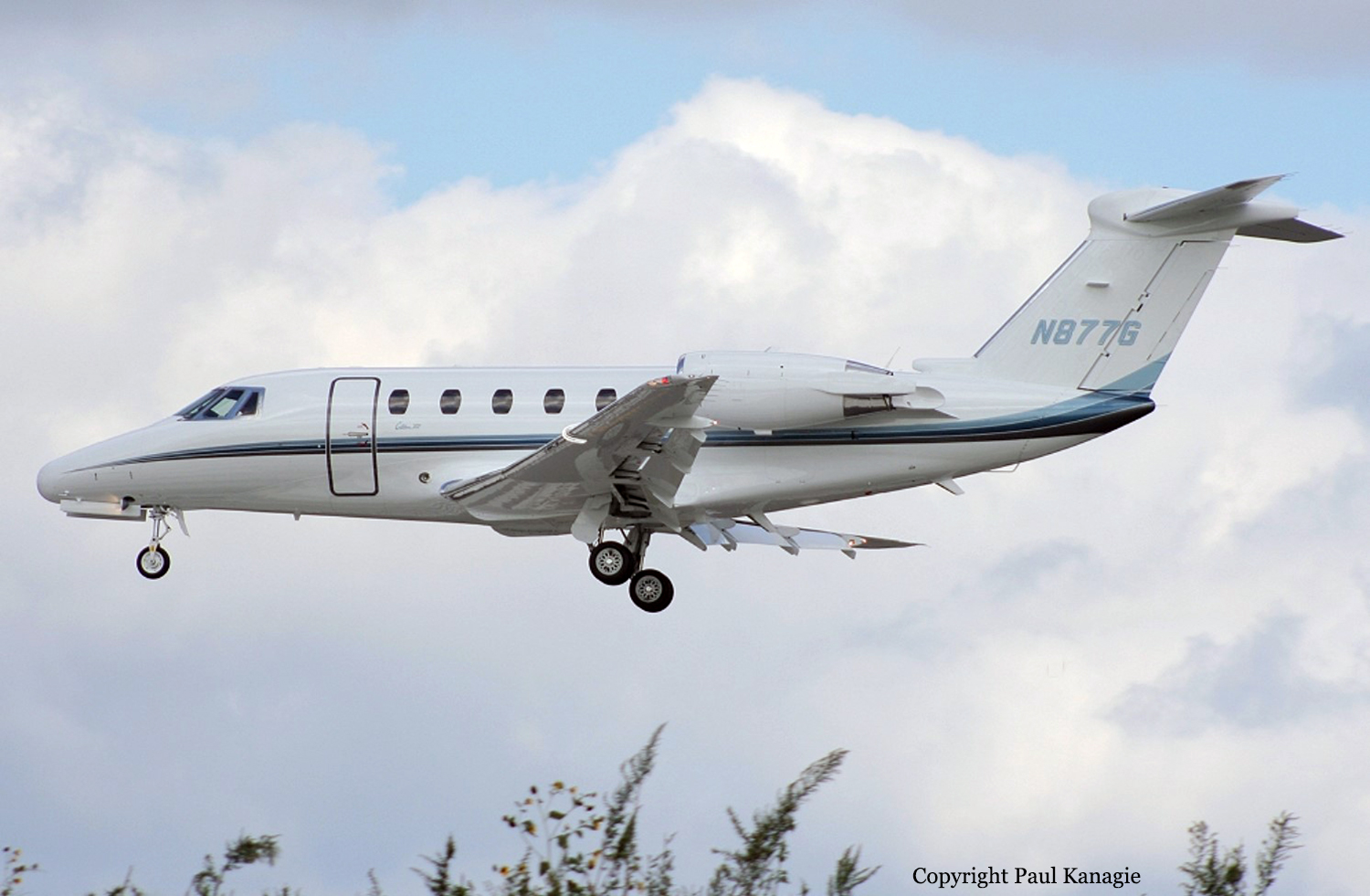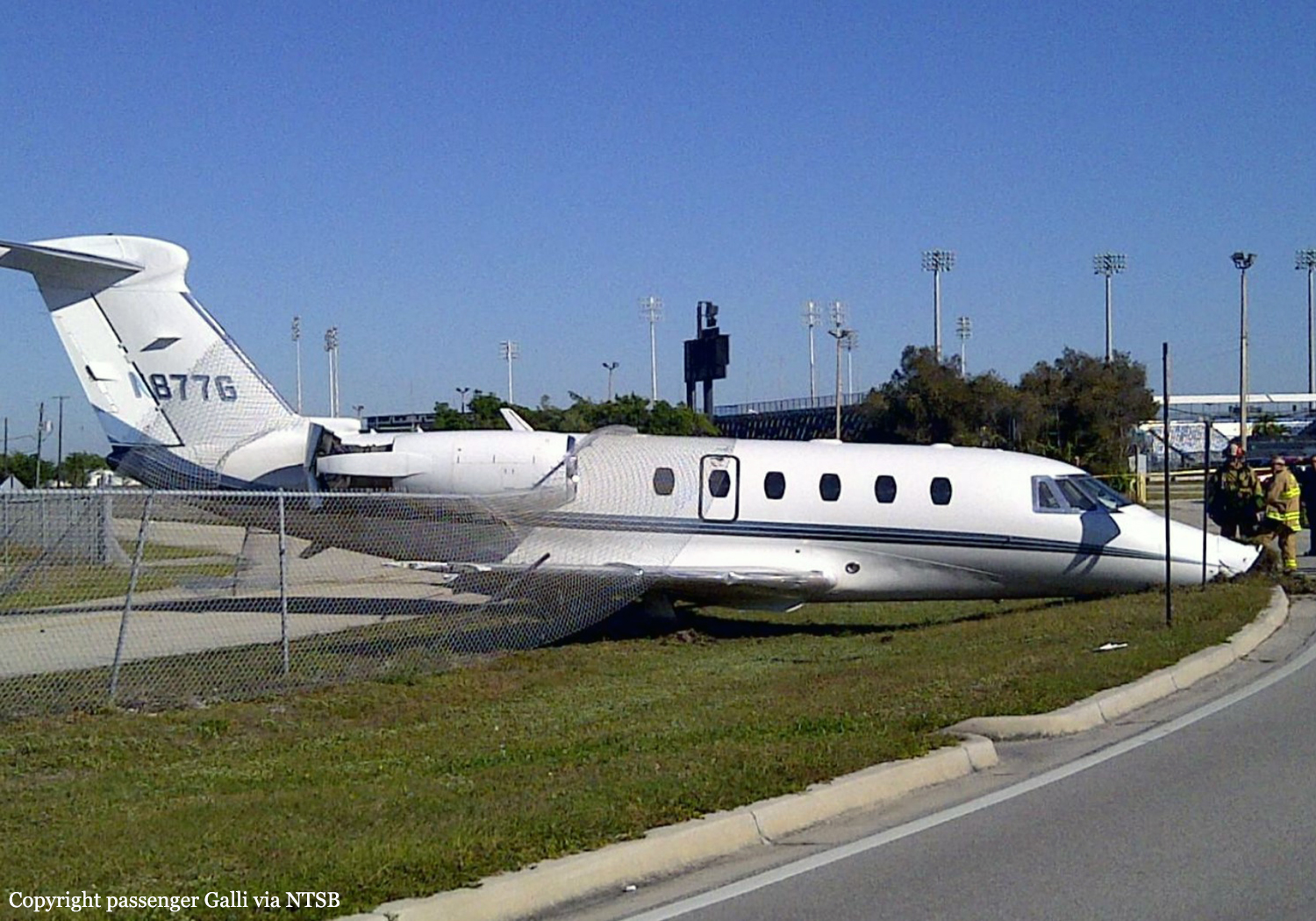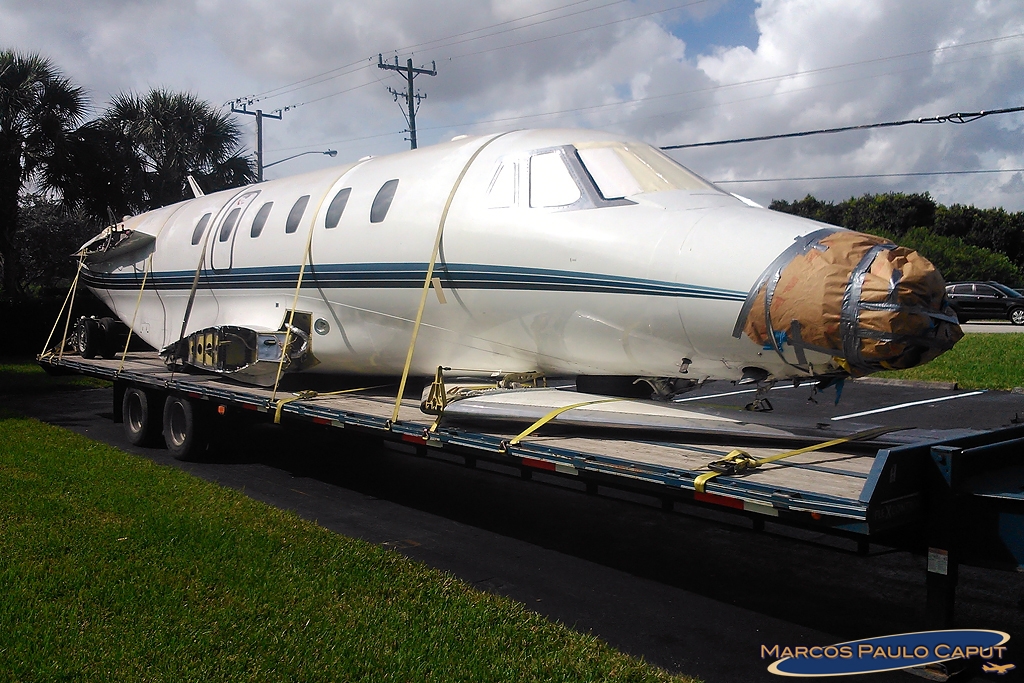Country
Crash of a Cessna 650 Citation VII in Istanbul
Date & Time:
Sep 21, 2017 at 2116 LT
Registration:
TC-KON
Survivors:
Yes
Schedule:
Istanbul - Ercan
MSN:
650-7084
YOM:
1998
Crew on board:
3
Crew fatalities:
Pax on board:
1
Pax fatalities:
Other fatalities:
Total fatalities:
0
Circumstances:
The aircraft departed Atatürk Airport in Istanbul at 2105LT bound for Ercan with a crew of three and one passenger on board. Shortly after takeoff, an unexpected situation forced the crew to return for an emergency landing. After touchdown on runway 35L, the twin engine aircraft went out of control, veered off runway, struck a concrete drainage ditch and came to rest, broken in two and bursting into flames. All four occupants evacuated safely while the aircraft was destroyed by a post crash fire.
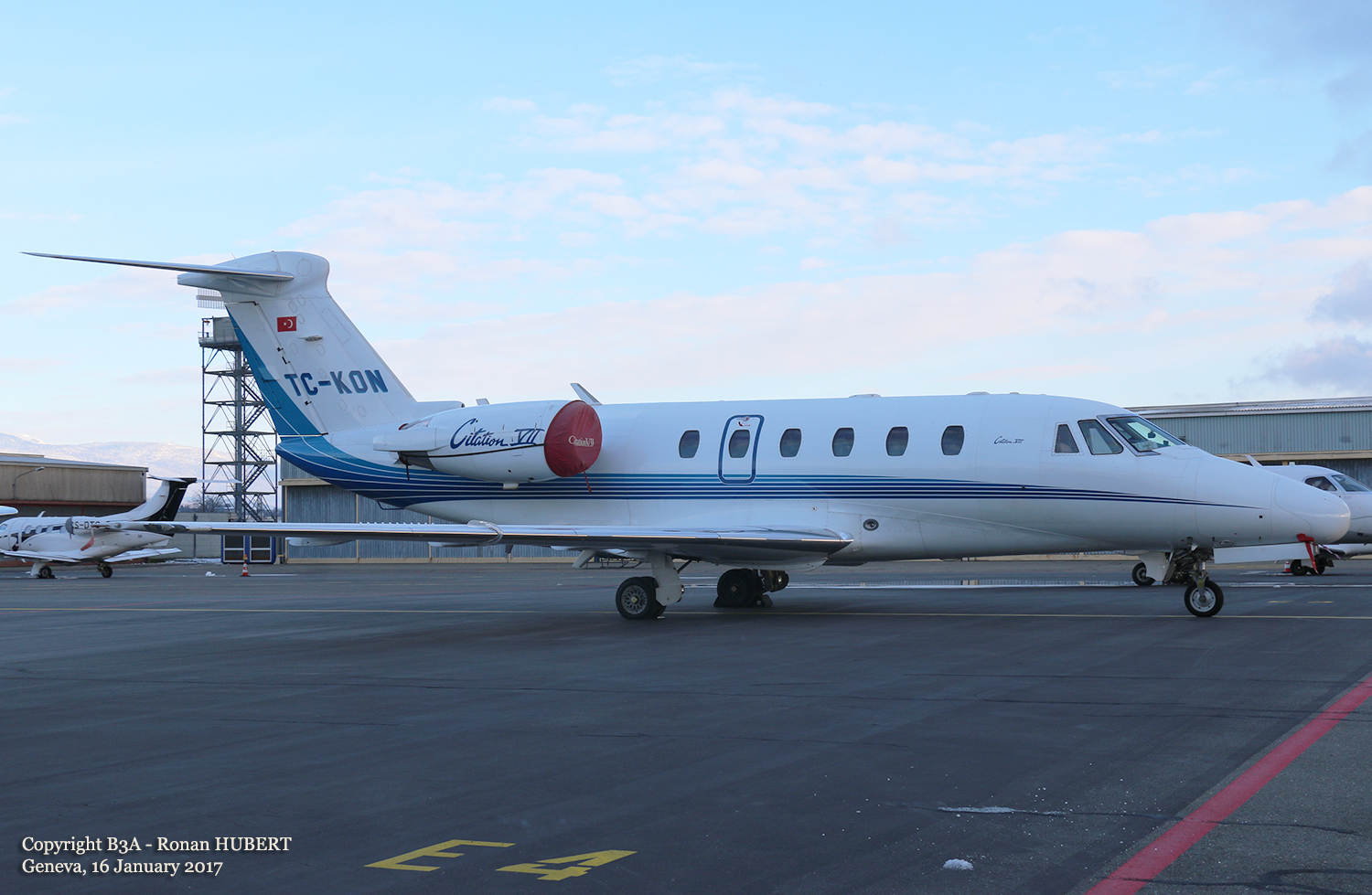
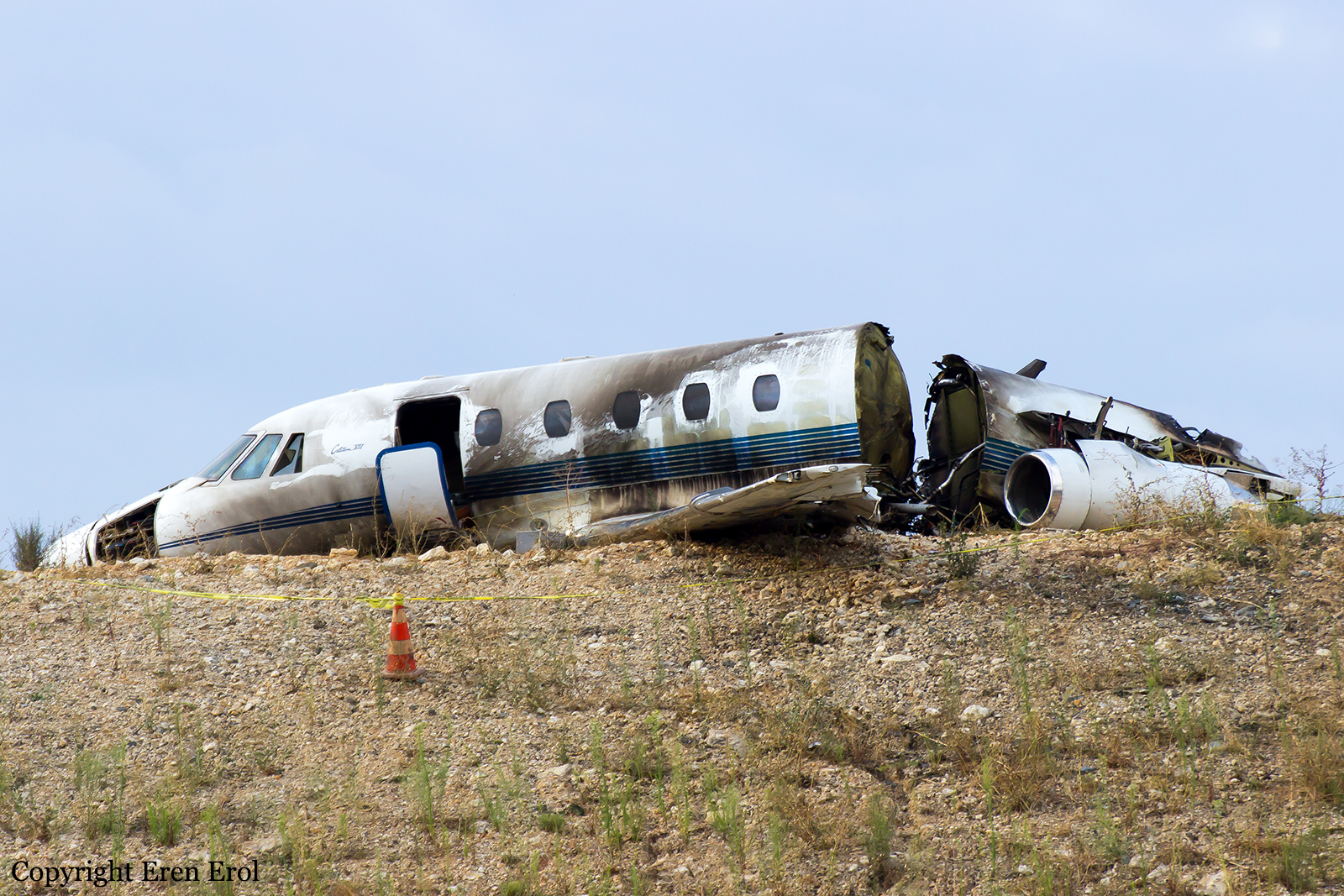
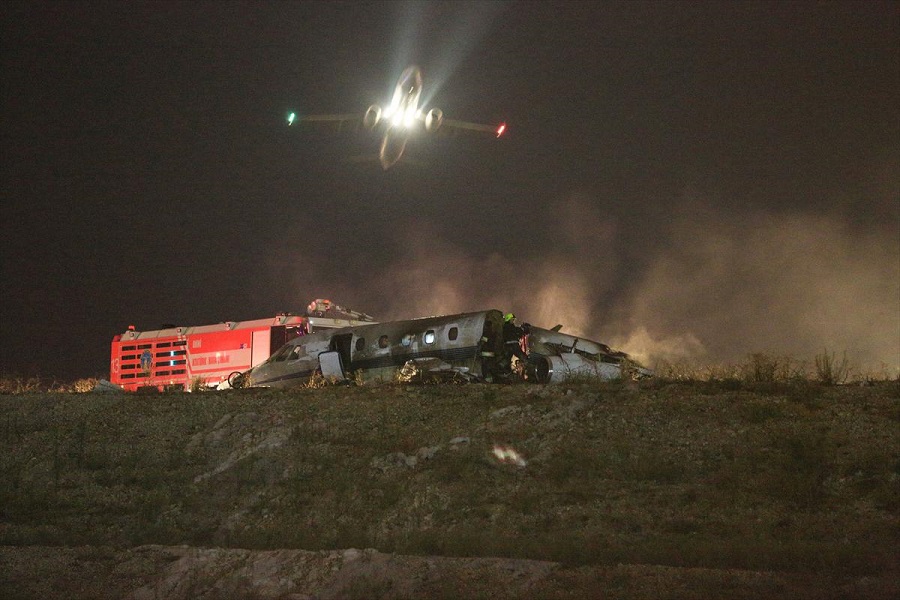
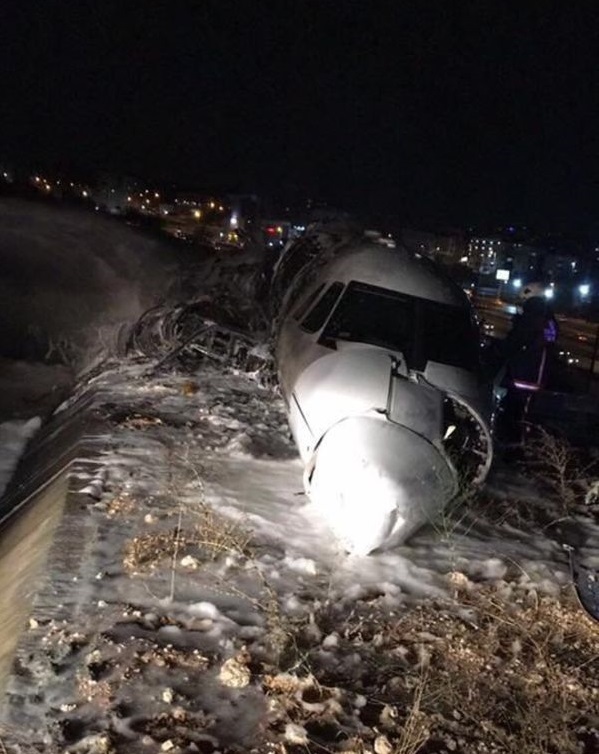
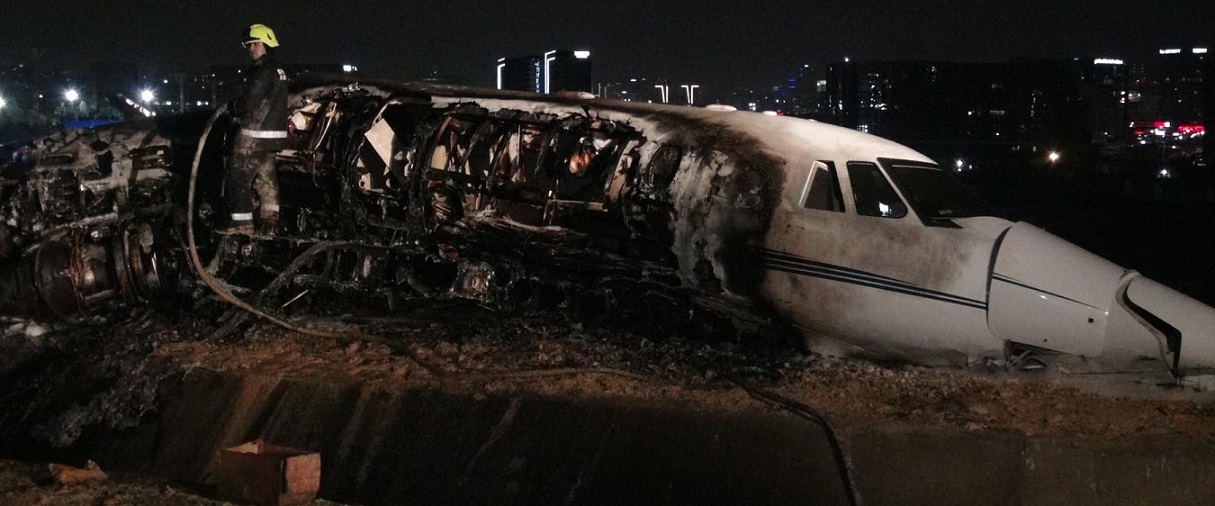
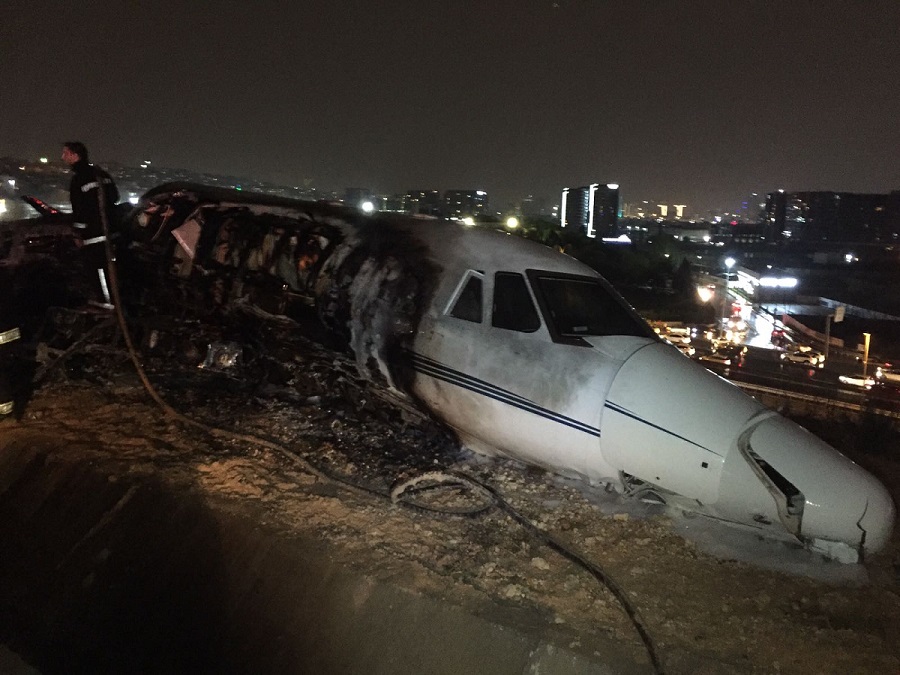
Crash of a Cessna 650 Citation VII in Guarda-Mor: 4 killed
Date & Time:
Nov 10, 2015 at 1904 LT
Registration:
PT-WQH
Survivors:
No
Schedule:
Brasília – São Paulo
MSN:
650-7083
YOM:
1998
Crew on board:
2
Crew fatalities:
Pax on board:
2
Pax fatalities:
Other fatalities:
Total fatalities:
4
Copilot / Total hours on type:
1633
Circumstances:
The aircraft took off from the Presidente Juscelino Kubitschek (SBBR) Aerodrome, Brasília - DF, to the Congonhas Aerodrome (SBSP), São Paulo - SP, at 2039 (UTC), to carry out a personnel transportation flight with two crewmembers and two passengers on board. During the cockpit preparation procedure, the crew members commented about the operation of the Pitch Trim System. The first flight of the day, that occurred in the morning, was from São Paulo to Brasilia and with no abnormalities. About thirty minutes after take-off from Brasília, still during the climb, near the FL370, the cabin voice recorder recorded a characteristic sound of the aircraft’s horizontal stabilizer moving. Then, the aircraft made a downward trajectory with high speed and a big rate of descent until the impact against the ground. The aircraft was destroyed. All occupants perished at the site, among them Lúcio Flávio de Oliveira and Marco Antonio Rossi, two Directors of Banco Brasdesco.
Probable cause:
Contributing factors:
- Control skills – undetermined
It is possible that, after inadvertent movement of the horizontal stabilizer, the crewmembers did not operate on the control switches of the secondary pitch trim system, since no other warning sound (Clacker) was recorded on the CVR recordings. The action prevised in the emergency procedures Pitch Trim Runaway or Failure, item 3, regarding trimming of the aircraft through the secondary system, possibly, was not performed. The performance of the crew may have been restricted only to the elevator control on the aircraft controls or to the control of the stabilizer associated with the primary trimming mode.
- Attitude – undetermined
The decision to make the flight without the proper functioning of the primary pitch trim and autopilot system may have been the result of the pilot's self-confidence because of the successful previous flight under similar operating conditions. Considering the hypothesis that the updated Shutdown Checklist, which should incorporate the Stabilizer Trim Backdrive Monitor - TEST, was not performed after the precrash flight, one could consider that there was a lack of adhesion to the aircraft operating procedures. Such an attitude could be associated with the pilot's self-confidence about the aircraft's operating routine, whose acquired experience could have given him the habit of ignoring some of the procedures deemed less important during the flight completion phase.
- Crew Resource Management – a contributor
Throughout the flight, there was an absence of verbalization and communication of the actions on the checklist. Similarly, in the face of the emergency situation of the horizontal stabilizer (Pitch Trim Runaway or Failure), no statements were identified regarding the actions required to manage this situation among the crew. These characteristics denote inefficiency in the use of human resources available for the aircraft operation.
- Training – undetermined
It is possible that the absence of a periodic training in simulator, especially the emergency Pitch Trim Runway or Failure, has affected the performance of the crew, as far as the CVR did not record statements related to the actions required by the abnormal condition experienced.
- Organizational culture – undetermined
The operator did not usually properly fill out the PT-WQH flight logbook. This condition evidenced the existence of informal rules regarding the monitoring of the operational conditions of the aircraft. In this context, it is possible that the history of failures related to the pitch trim system has not been registered.
- Piloting judgment – undetermined
Moments prior to takeoff, it was recorded in the CVR speeches related to the flight without the autopilot, possibly related to a failure or inoperativeness of the primary pitch trim system. The takeoff with a possible failure in the pitch trim system of the aircraft, showed an inadequate assessment of the risks involved in the operation under those conditions.
- Aircraft maintenance – undetermined
It was not possible to establish a link between the maintenance services performed on the aircraft in September 2015 and the events that resulted in the accident occurred on 10NOV2015. However, it was not ruled out that an incomplete crash survey was carried out in the pitch trim system of the aircraft, due to the lack of detail of the service orders.
- Decision-making process – a contributor
The sounds related to the test positions of the Rotary Test Switch have not been recorded in the CVR recording, so it is possible to conclude that the Warning Systems - Check item of the Cockpit Preparation Checklist has not been performed. The decision to perform the flight without the complete execution of all items of the Cockpit Preparation Checklist, prevented the correct verification of the primary longitudinal Trim system of the aircraft and reflected an inadequate judgment about the risks involved in that operation.
- Interpersonal relationship – undetermined
According to the CVR data, there was a possible rush of the crew to take-off, even though it was verified that the aircraft's pitch trim system did not work properly. It was not possible to determine if this rush was motivated by passengers’ pressure or self-imposed by the pilot.
- Support systems – undetermined
It is possible that the Pilots' Abbreviated Checklist - NORMAL PROCEDURES, aboard the aircraft, was outdated, without the incorporation of the Stabilizer Trim Backdrive Monitor - TEST procedure in the Shutdown Checklist. The possible completion of Shutdown Checklist with outdated procedures would have hampered the manufacturer's suggested verification for identification of abnormalities in the aircraft's pitch trim system.
- Managerial oversight – undetermined
The records and control of the operational check flights, both by the maintenance shop and by the operator, prevised in documentation issued by the manufacturer (SB650- 27-53 and ASL650-55-04) were not performed in an adequate manner, indicating possible weaknesses in the supervision of the maintenance activities.
- Control skills – undetermined
It is possible that, after inadvertent movement of the horizontal stabilizer, the crewmembers did not operate on the control switches of the secondary pitch trim system, since no other warning sound (Clacker) was recorded on the CVR recordings. The action prevised in the emergency procedures Pitch Trim Runaway or Failure, item 3, regarding trimming of the aircraft through the secondary system, possibly, was not performed. The performance of the crew may have been restricted only to the elevator control on the aircraft controls or to the control of the stabilizer associated with the primary trimming mode.
- Attitude – undetermined
The decision to make the flight without the proper functioning of the primary pitch trim and autopilot system may have been the result of the pilot's self-confidence because of the successful previous flight under similar operating conditions. Considering the hypothesis that the updated Shutdown Checklist, which should incorporate the Stabilizer Trim Backdrive Monitor - TEST, was not performed after the precrash flight, one could consider that there was a lack of adhesion to the aircraft operating procedures. Such an attitude could be associated with the pilot's self-confidence about the aircraft's operating routine, whose acquired experience could have given him the habit of ignoring some of the procedures deemed less important during the flight completion phase.
- Crew Resource Management – a contributor
Throughout the flight, there was an absence of verbalization and communication of the actions on the checklist. Similarly, in the face of the emergency situation of the horizontal stabilizer (Pitch Trim Runaway or Failure), no statements were identified regarding the actions required to manage this situation among the crew. These characteristics denote inefficiency in the use of human resources available for the aircraft operation.
- Training – undetermined
It is possible that the absence of a periodic training in simulator, especially the emergency Pitch Trim Runway or Failure, has affected the performance of the crew, as far as the CVR did not record statements related to the actions required by the abnormal condition experienced.
- Organizational culture – undetermined
The operator did not usually properly fill out the PT-WQH flight logbook. This condition evidenced the existence of informal rules regarding the monitoring of the operational conditions of the aircraft. In this context, it is possible that the history of failures related to the pitch trim system has not been registered.
- Piloting judgment – undetermined
Moments prior to takeoff, it was recorded in the CVR speeches related to the flight without the autopilot, possibly related to a failure or inoperativeness of the primary pitch trim system. The takeoff with a possible failure in the pitch trim system of the aircraft, showed an inadequate assessment of the risks involved in the operation under those conditions.
- Aircraft maintenance – undetermined
It was not possible to establish a link between the maintenance services performed on the aircraft in September 2015 and the events that resulted in the accident occurred on 10NOV2015. However, it was not ruled out that an incomplete crash survey was carried out in the pitch trim system of the aircraft, due to the lack of detail of the service orders.
- Decision-making process – a contributor
The sounds related to the test positions of the Rotary Test Switch have not been recorded in the CVR recording, so it is possible to conclude that the Warning Systems - Check item of the Cockpit Preparation Checklist has not been performed. The decision to perform the flight without the complete execution of all items of the Cockpit Preparation Checklist, prevented the correct verification of the primary longitudinal Trim system of the aircraft and reflected an inadequate judgment about the risks involved in that operation.
- Interpersonal relationship – undetermined
According to the CVR data, there was a possible rush of the crew to take-off, even though it was verified that the aircraft's pitch trim system did not work properly. It was not possible to determine if this rush was motivated by passengers’ pressure or self-imposed by the pilot.
- Support systems – undetermined
It is possible that the Pilots' Abbreviated Checklist - NORMAL PROCEDURES, aboard the aircraft, was outdated, without the incorporation of the Stabilizer Trim Backdrive Monitor - TEST procedure in the Shutdown Checklist. The possible completion of Shutdown Checklist with outdated procedures would have hampered the manufacturer's suggested verification for identification of abnormalities in the aircraft's pitch trim system.
- Managerial oversight – undetermined
The records and control of the operational check flights, both by the maintenance shop and by the operator, prevised in documentation issued by the manufacturer (SB650- 27-53 and ASL650-55-04) were not performed in an adequate manner, indicating possible weaknesses in the supervision of the maintenance activities.
Final Report:

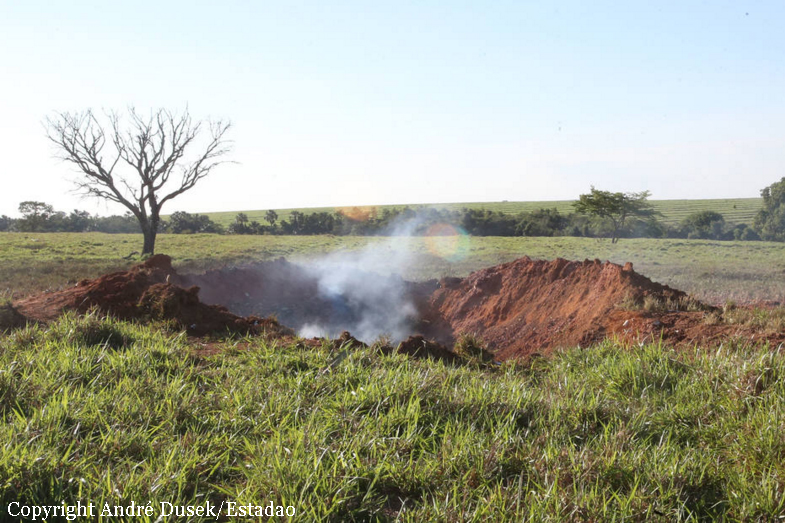

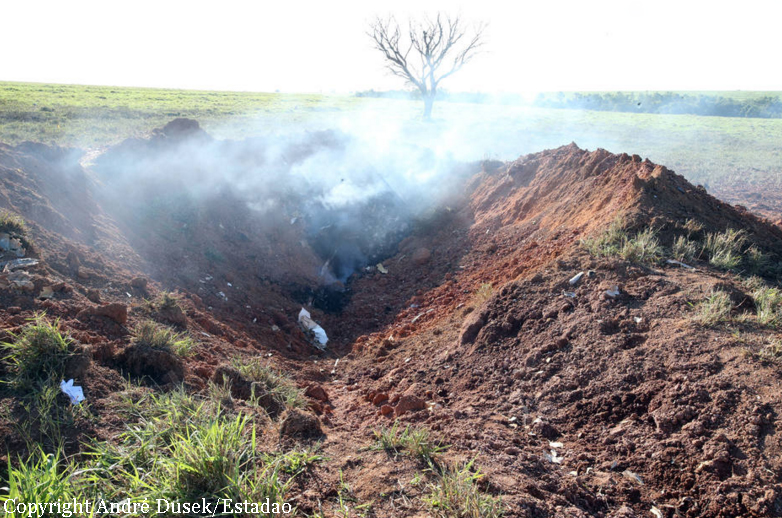
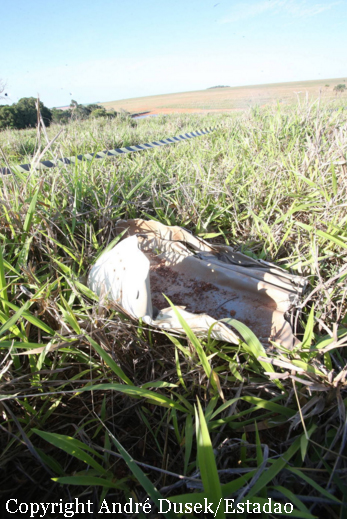
Crash of a Cessna 650 Citation VII in Fort Lauderdale
Date & Time:
Dec 28, 2011 at 0951 LT
Registration:
N877G
Survivors:
Yes
Schedule:
Lauderdale – Teterboro
MSN:
650-7063
YOM:
1995
Crew on board:
2
Crew fatalities:
Pax on board:
6
Pax fatalities:
Other fatalities:
Total fatalities:
0
Captain / Total hours on type:
190.00
Copilot / Total hours on type:
100
Aircraft flight hours:
5616
Aircraft flight cycles:
4490
Circumstances:
The crew stated that the preflight examination, takeoff checks, takeoff roll, and rotation from runway 26 were "normal." However, once airborne, and with the landing gear down and the flaps at 20 degrees, the airplane began a roll to the right. The captain used differential thrust and rudder to keep the airplane from rolling over, and as he kept adjusting both. He noted that as the airspeed increased, the airplane tended to roll more; as the airspeed decreased, the roll would decrease. The captain also recalled thinking that the airplane might have had an asymmetrical flap misconfiguration. Both pilots stated that there were no lights or warnings. As the airplane continued a right turn, runway 13 came into view. The captain completed a landing to the right of that runway, landing long and in the grass with a 9-knot, left quartering tailwind. The airplane then paralleled the runway and ran into an airport perimeter fence beyond the runway's end. The cockpit voice recorder revealed that the crew initially used challenge and reply checklists and that after completing the takeoff checklist, engine power increased. About 7 seconds after the first officer called "V1," the captain stated an expletive, and the first officer announced "positive rate." During the next 50 seconds, the captain repeated numerous expletives, an automated voice issued numerous "bank angle" warnings, and the first officer asked what he could do, to which the captain later told him to declare an emergency. There were no calls by either pilot for an emergency checklist nor were there callouts of any emergency memory items. Each of the airplane's wings incorporated four hydraulically-actuated spoiler segments. The outboard segment, the roll control spoiler, normally extends in conjunction with its wing aileron after the aileron has traveled more than about 3 degrees, and extends up to 50 degrees at full control wheel rotation. When the airplane was subsequently examined in a hangar, hydraulic power was applied to the airplane via a ground hydraulic power unit, and the right roll spoiler elevated to 7.9 degrees above the flush wing level. Multiple left/right midrange turns of the yoke, with the hydraulic ground power unit both on and off, resulted in the roll spoiler being extended normally, but still returning to a resting position of 7.8 to 7.9 degrees above the flush position. When the yoke was turned full right and left, whether the aileron boost was on or off, both wings' roll spoilers extended to their full positions per specifications; however, once the full deflection testing was completed, the right roll spoiler returned to 6.1 degrees above the flush position. A final yoke turn resulted in the roll spoiler being elevated to 5.5 degrees. The right wing roll spoiler actuator was subsequently examined at the airplane manufacturer, and the roll spoiler was found to jam. The roll spoiler actuator was disassembled, but no specific reason(s) for the jamming were found. The roll spoiler parts were also examined and no indications of why the actuator may have jammed were found. According to the flight manual, if any of the spoiler segments should float, moving the spoiler hold down switch to "Spoiler Hold Down" locks all spoiler panels down. The roll control spoilers may then be used in the roll mode by turning on the auxiliary hydraulic pump. Also, an "Aileron/Spoiler Disconnect" T-handle is available to release the tie between the ailerons and the roll control spoilers in the event of a jam in either system. When used, the pilot's yoke controls only the ailerons, and the copilot's yoke controls only the roll control spoilers. Although the jamming of the right spoiler initiated the event, the crew's proper application of emergency procedures should have negated the adverse effects. Memory items for an uncommanded roll include moving the spoiler hold-down switch to the "on" position, which was not done; the spoiler hold-down switch was found in the "off" position. (The captain thought that he may have had an asymmetrical flap configuration; however, if an asymmetry had been the initiating event, the flap system would have been automatically disabled and the flap segments would have been mechanically locked in their positions.) The aileron/spoiler disconnect T-handle was found pulled up, which the crew indicated had occurred when the first officer's shoe hit it as he evacuated the airplane. While pulling the aileron/spoiler disconnect T-handle would have been appropriate for a different emergency procedure to release the tie between the ailerons and the roll control spoilers in the event of a jam in either system, it would have actually hindered the captain's attempts to control the airplane in this case because it would have disconnected the left roll spoiler from the captain's yoke, making it more difficult to counter the effects of the displaced right roll spoiler. Although the crew indicated that the t-handle was pulled during the first officer's exit of the airplane, its position, safety cover, and means of activation make this unlikely. In addition, precertification testing of the airplane showed that even with the right roll spoiler fully deployed, as long as the pilot had the use of the left roll spoiler in conjunction with that aileron, the airplane should have been easily controlled.
Probable cause:
The crew's failure to use proper emergency procedures during an uncommanded right roll after takeoff, which led to a forced landing with a quartering tailwind. Contributing to the accident was a faulty right roll spoiler actuator, which allowed the right roll spoiler to deploy but not close completely.
Final Report:
